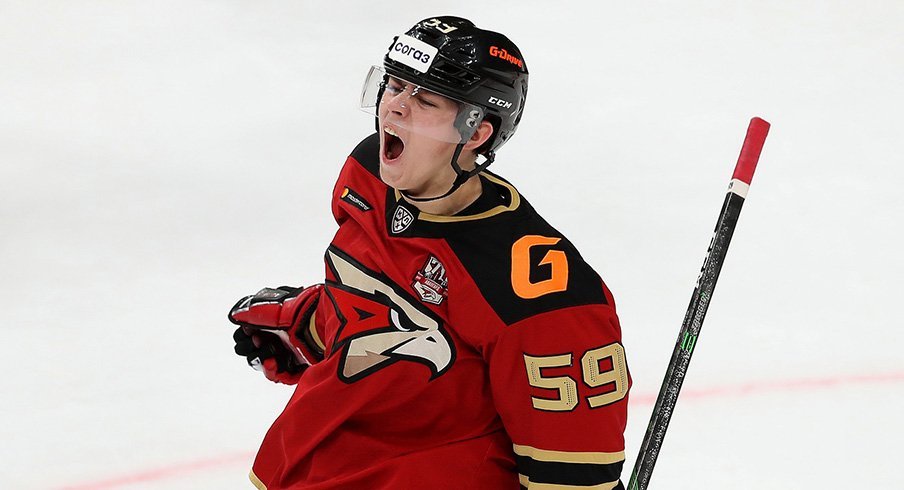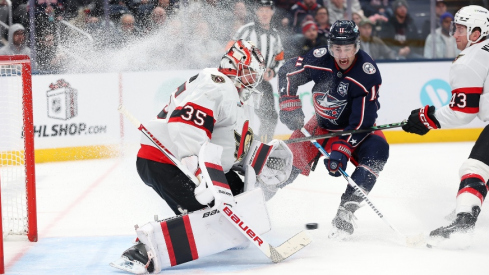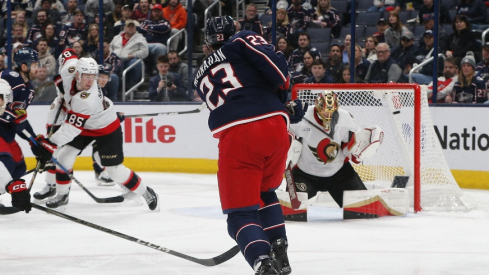Columbus Blue Jackets GM Jarmo Kekalainen and his scouting staff believe they've found a market inefficiency at the NHL Draft.
Russian players.
Between Vladislav Gavrikov, Kirill Marchenko, Dmitry Voronkov, Daniil Tarasov, Vitaly Abramov, and Yegor Chinakhov, the Blue Jackets have recently spent serious draft capital selecting players from Russia.
On the surface, there's not much to see here. Gavrikov has come to Columbus as advertised as a no-frills, second-pairing defenseman. Marchenko is considered by many to be the organization's top prospect. Tarasov is their top goalie prospect.
On the other hand, Russian players are (somehow still) overlooked on NHL Draft day. Artemi Panarin was never drafted despite an electrifying performance at the 2011 World Junior Championships, arguably the most widely-scouted game on the calendar in 2011. Tampa Bay winger Nikita Kucherov just had more assists in a playoff season than anybody not named Gretzky or Lemieux, and yet he was taken 58th overall.
There are plenty of nuances that come with the territory of drafting Russian players, so allow us to break down the pros and cons:
Cons
For sake of flow, it actually makes more sense to start with the potential problems associated with drafting a player from Russia.
Contract Extensions
Let's just address the elephant in the room. The KHL is one of the top professional hockey leagues in the world. It's also "home" for these players. And lastly, there's serious money to be had, particularly if playing for one of the large-market, name-brand organizations. Simply put, there's no guarantee that a player will come to the NHL, ready or not.
Recent reports have suggested Chinakhov will sign a three-year extension with the KHL's Avangard Omsk, which means it would be 2024-25 before he is willing to play in the NHL (assuming he's an NHL player is an entirely different discussion). Per the Columbus Dispatch, no such decision has been made, but the point remains that nobody selects a first-round pick with the hope or expectation that a player will be in your lineup four seasons from now.
If Chinakhov decides to sign that extension, he won't be the first Russian Blue Jackets draft pick in recent memory to do so; In 2017, Gavrikov was in Columbus for the first time on a de-facto recruiting trip when news broke that he had signed a two-year extension in the KHL.
If Chinakhov signs that extension, the timetable for North American arrival of #CBJ Russian forward prospects would be as follows:
— Aaron Portzline (@Aportzline) October 11, 2020
Kirill Marchenko, 2022-23
Dmitry Voronkov, 2023-24
Yegor Chinakhov*, 2024-25
2/2
Thanks, @coreypronman, for the Chinakhov heads-up.
Development Control
When a player is selected from the CHL or NCAA, the expectation is that the NHL club will be able to, at least in some small way, influence that player's development. But a young player skating in the KHL is unlikely to have the same level of attention. That isn't to say the Blue Jackets don't have a European development presence; they absolutely do. But it's a different animal when they're playing in AHL Cleveland playing underneath the organization's umbrella.
It's not a coincidence that we never saw Gavrikov or Marchenko at a development camp. And while development camp is a super small piece to a player's overall development, the larger point remains that a KHL player is more likely to be outside the purview of the club's development staff.
Pros
High Skill
If an 18/19-year old player is playing in the KHL, odds are he's a halfway decent player. As a rule, more players are being drafted from Russia than in the past. Marchenko, Voronkov, and Chinakhov are all key cogs on their respective KHL teams, and the expectation is they will be impact players at the NHL level.
Avangard's PPG from the right face-off circle? That's right, this is Yegor Chinakhov. pic.twitter.com/BVoxDWD7NH
— KHL (@khl_eng) October 12, 2020
Projectability
While the ice surface is bigger in Europe than in North America, I would argue that it's easier to scout a player in the KHL than the OHL. If a player is dominant at the OHL level, it could be because he's simply bigger, faster, or more physically mature than his peers. At the KHL, there is less room for variances. If a player is excelling against men, there's a good chance he'll perform well against men in North America.
Of course, there are exceptions. Emil Bemstrom lit up the SHL in 2018-19 and was in and out of the lineup in the NHL in his rookie season. But it's not going out on a limb to say that Chinakhov's 6-2-8 in 12 game stat line to start the KHL season (at the time of the draft) didn't hurt his prospects in the Blue Jackets' eyes.
Cost Certainty
Drafting NCAA players is trendy and for good reason. But these players are out of your system if not retained in a relatively short time horizon. On the other hand, unsigned Russian players' rights are held by the club indefinitely. That gives the club flexibility and cost certainty in the long run, without having to burn one of the allotted 50 organizational contracts. It's a little thing until it's not.
Conclusion
Ther are certain risks associated with drafting Russian-born players. But at the end of the day, the high-end skill coming out of Russia is a major reason why the Tampa Bay Lightning (Kucherov, Mikhail Sergachev, Andrei Vasilevskiy) recently hoisted the Stanley Cup.
The Blue Jackets have selected one Russian player in each of the past six drafts. Abramov has moved on via trade, but the other five (Gavrikov, Tarasov, Marchenko, Voronkov, Chinakhov) are seen as key assets for the present and future of the organization.
And for Kekalainen and company, the cost of waiting is worth the price.


